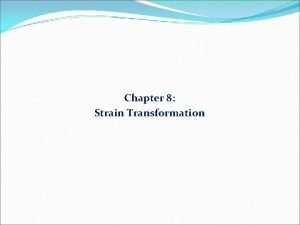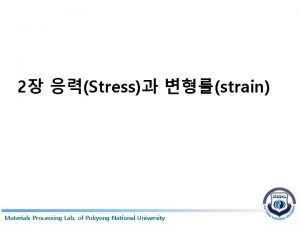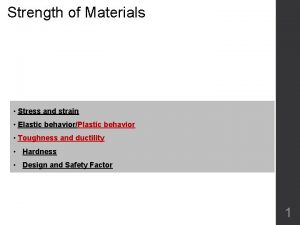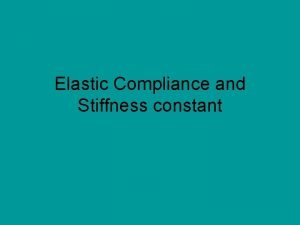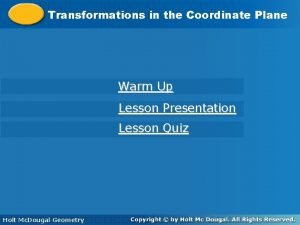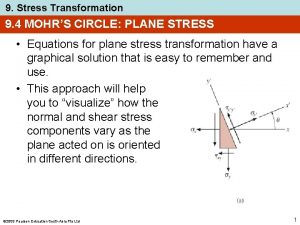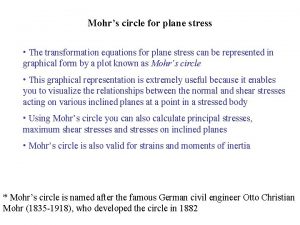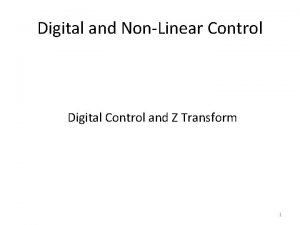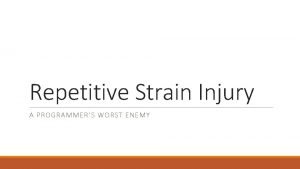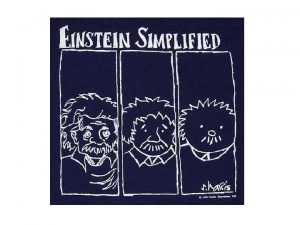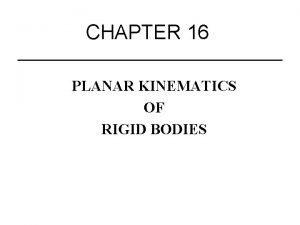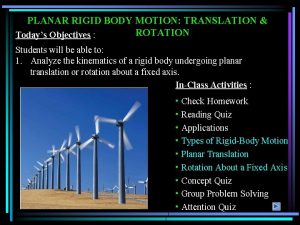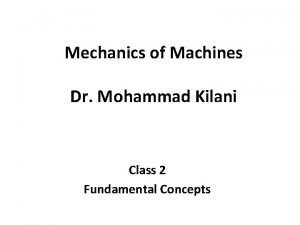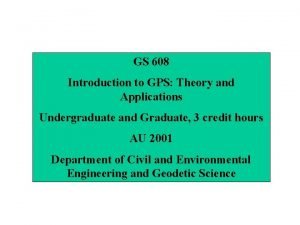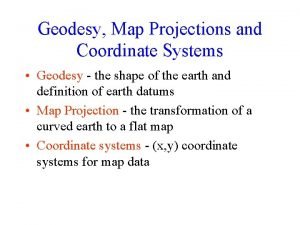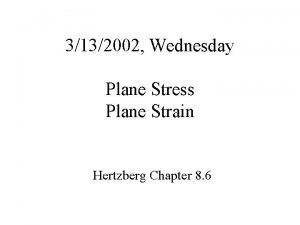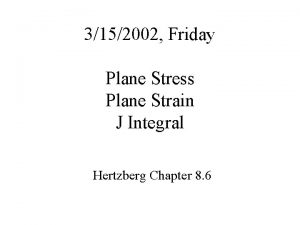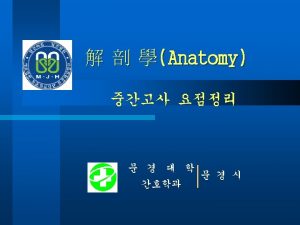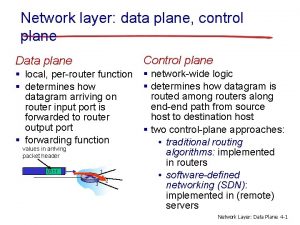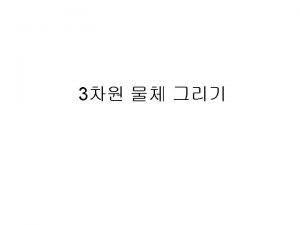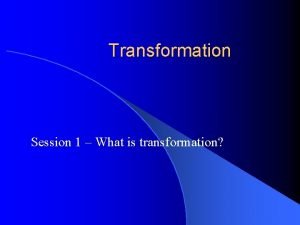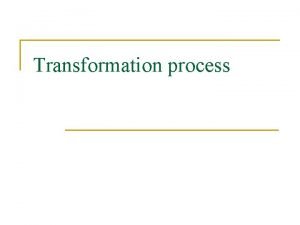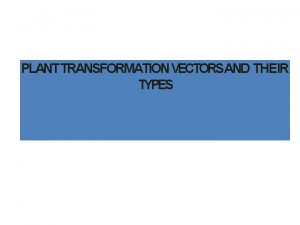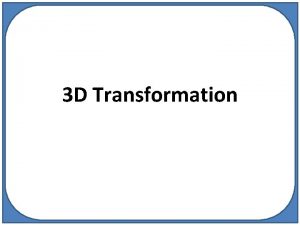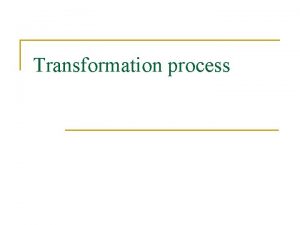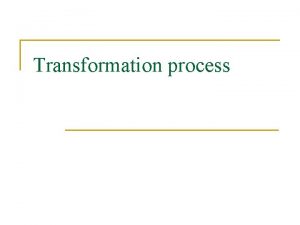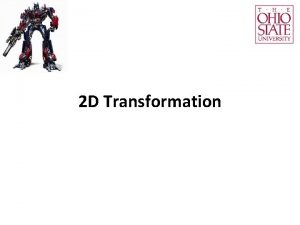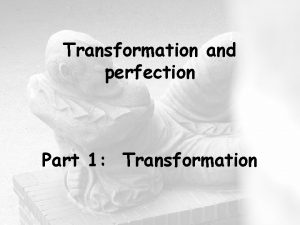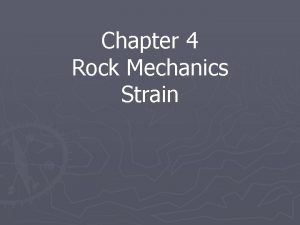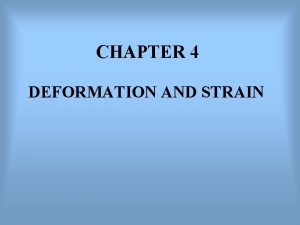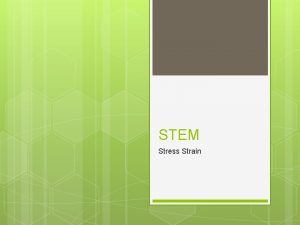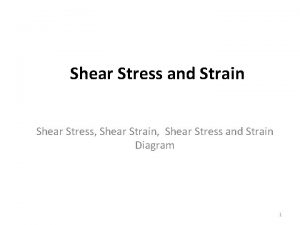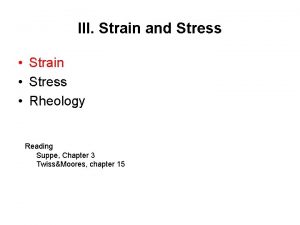Chapter 8 Strain Transformation Plane Strain General state






















- Slides: 22

Chapter 8: Strain Transformation

Plane Strain General state of strain at a point in a body is represented by 3 normal strains and 3 shear strains. The normal and shear strain components will vary according to the orientation of the element.

General Equations of Plane-Strain Transformation Strain-transformation equations

General Equations of Plane-Strain Transformation Principal Strains Maximum In-Plane Shear Strain Maximum in-plane shear strain and associated average normal strain are as follow:

Example 10. 3 A differential element of material at a point is subjected to a state of plane strain defined by which tends to distort the element. Determine the maximum in-plane shear strain at the point and the associated orientation of the element. Solution: Looking at the orientation of the element, For maximum in-plane shear strain,

Mohr’s Circle—Plane Strain We can also solve problems involving the transformation of strain using Mohr’s circle. It has a center on the ε axis at point C(εavg, 0) and a radius R.

Example 10. 5 The state of plane strain at a point is represented by the components Determine the maximum in-plane shear strains and the orientation of an element. Solution: From the coordinates of point E, we have To orient the element, we can determine the clockwise angle,

Absolute Maximum Shear Strain Absolute maximum shear strain is found from the circle having the largest radius. It occurs on the element oriented 45° about the axis from the element shown in its original position.

Absolute Maximum Shear Strain Plane Strain For plane strain we have, This value represents the absolute maximum shear strain for the material.

Example 10. 7 The state of plane strain at a point is represented by the strain components, Determine the maximum in-plane shear strain and the absolute maximum shear strain. Solution: From the strain components, the centre of the circle is on the ε axis at Since , the reference point has coordinates Thus the radius of the circle is

Solution: Computing the in-plane principal strains, we have From the circle, the maximum in-plane shear strain is From the above results, we have Thus the Mohr’s circle is as follows,

Strain Rosettes Normal strain in a tension-test specimen can be measured using an electrical-resistance strain gauge. The strain-transformation equation for each gauge is as follow:

Example 10. 8 The state of strain at point A on the bracket is measure using the strain rosette as shown. Due to the loadings, the readings from the gauge give εa = 60(10 -6), εb = 135(10 -6) and εc = 264(10 -6). Determine the in-plane principal strains at the point and the directions in which they act. Solution: Measuring the angles counter-clockwise, By substituting the values into the 3 strain-transformation equations, we have Using Mohr’s circle, we have A(60(10 -6), 60(10 -6)) and center C (153(10 -6), 0).

Material-Property Relationships Generalized Hooke’s Law For a triaxial state of stress, the general form for Hooke’s law is as follow: They are valid only for a linear–elastic materials. Hooke’s law for shear stress and shear strain is written as

Material-Property Relationships Relationship Involving E, v, and G Dilatation and Bulk Modulus Dilatation, or volumetric strain, is caused only by normal strain, not shear strain. Bulk modulus is a measure of the stiffness of a volume of material. Plastic yielding occurs at v = 0. 5.

Example 10. 10 The copper bar is subjected to a uniform loading along its edges. If it has a = 300 mm, b = 500 mm, and t = 20 mm before load is applied, find its new length, width, and thickness after application of the load. Take Solution: From the loading we have The associated normal strains are determined from the generalized Hooke’s law, The new bar length, width, and thickness are therefore

Theories of Failure for ductile material is by yielding, while brittle material is by fracture. Ductile Materials For yielding of a ductile material, it occurs along the contact planes. Maximum-shear-stress theory or Tresca yield criterion is used to predict the failure stress of a ductile material subjected to any type of loading.

Theories of Failure Ductile Materials With reference from plane stress, the maximumshear-stress theory for plane stress can be expressed for any two in-plane principal stresses.

Theories of Failure Ductile Materials The energy per unit volume of material is called the strain-energy density. Yielding in a ductile material occurs when the distortion energy per unit volume of the material equals or exceeds the distortion energy per unit volume. It is called the maximum-distortion-energy theory.

Theories of Failure Brittle Materials Maximum-normal stress theory states that a brittle material will fail when maximum principal stress is equal to the ultimate normal stress.

Example 10. 14 The solid shaft has a radius of 0. 5 cm and is made of steel having a yield stress of σ = 360 MPa. Determine if the loadings cause the shaft to fail according to the maximum-shear-stress theory and the maximum-distortion-energy theory. Solution: Since maximum shear stress caused by the torque, we have Principal stresses can also be obtained using the stress-transformation equations,

Solution: Since the principal stresses have opposite signs, the absolute maximum shear stress will occur in the plane, Thus, shear failure of the material will occur according to this theory. Using maximum-distortion-energy theory, Using this theory, failure will not occur.
 Principal strain equation
Principal strain equation 후크의 법칙
후크의 법칙 Software-defined networking: a comprehensive survey
Software-defined networking: a comprehensive survey Elastic strain and plastic strain
Elastic strain and plastic strain Elastic compliance and stiffness constants
Elastic compliance and stiffness constants Identify the transformation from abc to a'b'c'
Identify the transformation from abc to a'b'c' Transformation in the coordinate plane
Transformation in the coordinate plane Stress transformation example
Stress transformation example Mohr circle equations
Mohr circle equations Forwarding equivalence classes
Forwarding equivalence classes Z transform is a non-linear operation
Z transform is a non-linear operation Enemy of the state strain
Enemy of the state strain Lorentz transformation
Lorentz transformation Planar kinematics
Planar kinematics A body subjected to general plane motion undergoes
A body subjected to general plane motion undergoes Grashof
Grashof Pennsylvania state plane zones
Pennsylvania state plane zones Ca state plane zones
Ca state plane zones Rrc gis viewer
Rrc gis viewer Utm zones virginia
Utm zones virginia Texas state plane zones
Texas state plane zones Texas state plane zones
Texas state plane zones Lambert projection
Lambert projection
